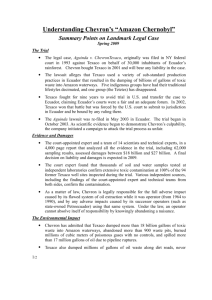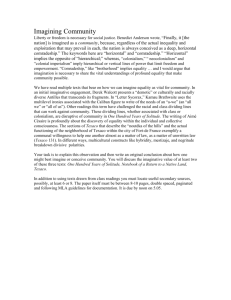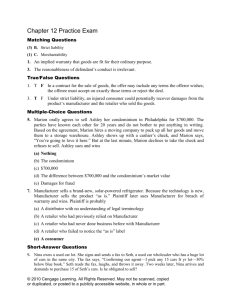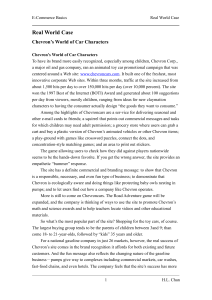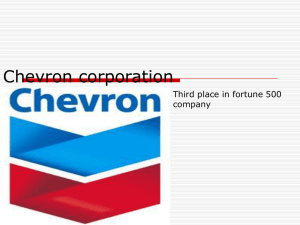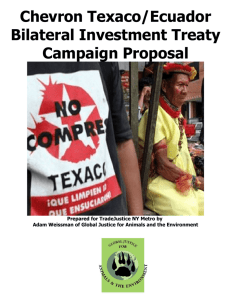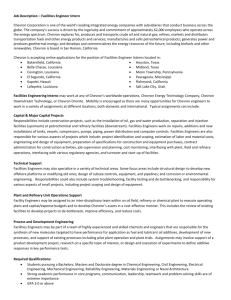CHEVRON TRIAL IN ECUADOR
advertisement
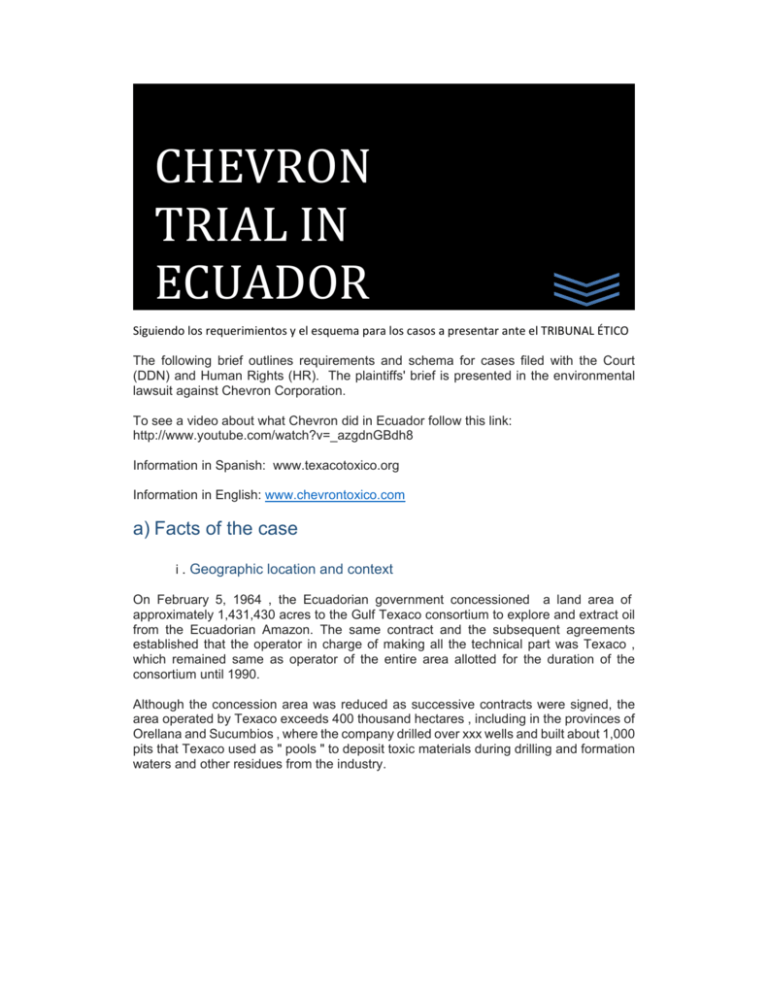
CHEVRON TRIALIN ECUADOR Siguiendo los requerimientos y el esquema para los casos a presentar ante el TRIBUNAL ÉTICO The following brief outlines requirements and schema for cases filed with the Court (DDN) and Human Rights (HR). The plaintiffs' brief is presented in the environmental lawsuit against Chevron Corporation. To see a video about what Chevron did in Ecuador follow this link: http://www.youtube.com/watch?v=_azgdnGBdh8 Information in Spanish: www.texacotoxico.org Information in English: www.chevrontoxico.com a) Facts of the case i . Geographic location and context On February 5, 1964 , the Ecuadorian government concessioned a land area of approximately 1,431,430 acres to the Gulf Texaco consortium to explore and extract oil from the Ecuadorian Amazon. The same contract and the subsequent agreements established that the operator in charge of making all the technical part was Texaco , which remained same as operator of the entire area allotted for the duration of the consortium until 1990. Although the concession area was reduced as successive contracts were signed, the area operated by Texaco exceeds 400 thousand hectares , including in the provinces of Orellana and Sucumbios , where the company drilled over xxx wells and built about 1,000 pits that Texaco used as " pools " to deposit toxic materials during drilling and formation waters and other residues from the industry. ii . How was the situation before Texaco The native people of the Ecuadorian Amazon are characterized by a harmonious relationship with their environment, which they know to take from the environment only in relation to your needs without breaking the balance with nature . The area where Texaco operated was characterized by high biodiversity and abundant resources for Amazonian residents, who did not know needs and poverty because the forest provided everything they needed : the jungle supplied food, drink , shelter, served as school , church, library and pharmacy. They did not know of diseases such as cancer. iii . Chronological narrative of events. The litigation against Texaco was initially raised in New York City, the global headquarters of Texaco, on November 3, 1993 . This year, about 30,000 Ecuadorians, indigenous people and settlers, directly or indirectly affected by the activities of Texaco in their territories, represented by a group of people filed a legal complaint in the United States. Plaintiffs expected that U.S. courts would accept the case because of their extensive trial experience with environmental pollution, and supported their order with 3 arguments: 1 ) the proven fact that the Directors of Texaco made the relevant technical decisions for the operation in Ecuador, from its offices in New York , 2) that the Texaco company no longer operated in Ecuador in 1993 , and 3) that the Texaco assets were in USA . However, on August 16, 2002 , the Court of Appeals for the Southern District of New York, after nine years of legal battle in the United States, decided against the lawsuit filed by Ecuadorian people : a. That the applicants are entitled to a trial , so arranged that Texaco should undergo in the Ecuadorian courts and comply with any judgment against Texaco, arguing that this was a more appropriate for this case for the reason that the documents , witnesses and other evidence were in Ecuador; b . Granted one year for applicants to take effective legal action before the Ecuadorian court, during which it ruled that Texaco could not plead statute of limitations for actions; c . The judgment rendered by the Ecuadorian courts will be enforceable in a U.S. court . On May 7, 2003, those affected by Texaco's operations initiated legal action against the oil in the Superior Court of Justice of Sucumbios . The legal basis of the claim is supported by the Ecuadorian Civil Code which granted class action for damages , recognizing "the obligation to repair the damage resulting from the negligence or willful misconduct " (art. 2241 and 2256, initially passed into law in the century 19). The Organic Law of Environmental Management determines the procedure to be followed in cases of environmental nature. The lawsuit alleges that Texaco caused environmental damage by the use of technology and polluting practices in violation of Ecuadorian law, claiming to prevent damage to the ecosystem and the use of "modern and efficient technology." The defendant defends by arguing that these were the methods regularly used by the oil industry , even though these methods were expressly prohibited by law in Texas since 1919 and Louisiana in 1953, which were especially severe pollution sources of drinking water . After 10 years of litigation before the Ecuadorian courts, the plaintiffs prevailed in the two lower courts and won the November 12, 2012 ratification of the judgment against Chevron Corporation (formerly Texaco) by the National Court for all environmental damages caused - although the fine imposed punitive damages. However, despite these victories before the competent courts the company refuses to recognize the judgment against them, and instead has decided to accuse his victims of trying to extort and has undertaken an international campaign of defamation and attacks on applicants, their attorneys, representatives and anyone engaged with the cause. b ) Determination of damage: On the date on which the claim is presented the concept of rights of nature was not included or discussed during trial about the rights of nature, but the focus remained from the perspective of repairing environmental damage affecting rights of individuals . The complaint alleged that the environment was affected by the practices employed by Texaco, and that this involvement affected the environmental health and lives . Among the practices used by Texaco in Ecuador include building pools without coatings, and dumping of formation water into natural water sources on which thousands depended, the spraying of crude oil on the roads (presumably to avoid dust ), the technique of gas burning anti concealment rather spill cleaning. The truth is that the trial has demonstrated that in 1971 and 1974 Texaco had obtained U.S. patents on technology for reinjection of formation waters, which was a system used by the U.S. Texaco. These improvements demonstrated that they had the ability to avoid environmental damage, but they preferred to save investment in Ecuador . That is, deliberately and for economic, Texaco used polluting processes for its operations in Ecuador . The best proof of the various Texaco damages are the judgments that condemn, as they in turn refer to the laboratory and different reports that were presented throughout the trial. Because Chevron has already been convicted of this enormous environmental damage, we do not seek this Court to appear again on the existence of these, but we requested a ruling and order against the Chevron Company for the damage they cause because they refuse to serve the sentence and prosecute their victims. Chevron has enormous economic capacity, but instead of using it to meet the reparations ordered in the environment and the health of Ecuadorians, has decided to use its resources for refusing to serve the sentence , prosecuting for conspiracy and Amazonian extortion before a judge in New York, and also the Government of Ecuador in international arbitration of investment protection. This being the environmental damage that was never proven at trial will be repaired , which in fact is a mere sentence imposed by Chevron perpetually on nature - and Amazon populations that depend on it . In short, Chevron 's refusal to comply with this sentence because the permanence of enormous environmental damage , and this makes Chevron also infringing on the Rights of Nature. Specifically talking about the Rights of Nature, we can say that the right to exist (and therefore the restoration) integral nature is violated by the presence of environmental damage that have not been repaired due to the refusal of Chevron to serve this sentence. i . Environmental damage : specification and testing . Environmental damage based on the various reports submitted to the court by experts that demonstrated the existence of damages that are caused by oil exploration activities are observed Texaco . Damage testing for the presence of TPH in the soils of the concession area , demonstrating the widespread presence of hydrocarbons. Likewise other hazardous elements , such as benzene , toluene , PAHs and heavy metals and / or corrosion inhibitors such as chromium VI , mercury is observed barium . All these elements except barium, are reportedly carcinogenic health agencies , international and United States of America. As for water intake Texaco itself, who admitted dumping more than 16 billion gallons of formation water in the rivers of the Amazon , which is further confirmed by the presence of TPH and other elements like chromium showed VI and in general elements of hydrocarbons in surface waters. Groundwater also have been affected by seepage from unlined pools built . ii . Damage to persons , groups or communities : specification and testing . Land damages are a permanent health threat to locals and, therefore, must be removed, and be subject to appropriate treatment and disposal techniques, as requested by the plaintiffs. The same applies to the water, the terms of potability, flow and purity should be preserved by Texaco, as they contain evidence of contaminants that can affect human health , as well as the flora fauna and hunting and consequently fishing activities of the inhabitants of the Amazon. The human right to health can be compromised for environmental damage . In our case we noticed an increase in the incidence of cancer from exposure of people and other living oil and other contaminants used to exploit beings. In the judgment numerous statistical studies showing a cause and effect between oil exposure and increased cancer are cited. Additionally, as evidence of the existence of health problems, the judge considered testimony from dozens of people who agree talk about their sufferings because of pollution. The right to food and the way of life of those affected was dramatically impacted by the activities of Chevron's responsibility . The people who fed on what the forest provided them by hunting and fishing harvest were devoid of its power supply , escaping terrified by the sudden noise and pollution . So they went from having no needs to be forced to work in order to have some money with which to buy food and trying to meet their changing needs . iii . Impact assessment in the future. The consequences of the contamination left by Texaco (now Chevron ) will continue to be felt in the flesh and bone of the affected permanently until various measures of reparation ordered in judgment are effectively implemented. A victory in the courts does not serve to repair damage if left in the paper . c ) Determination of Responsibility: i . Responsible for public action or / and omission : specify if state governments public entities . There is a huge responsibility of the Ecuadorian State who historically neglected these affected areas of land, which made it possible to Texaco in Ecuador operate as if they were in the desert of Texas. This would be a sin of omission, because the State never took over operations of the concession area until 1992 - and our complaint was filed in 1993 , so could not include damage liability Petroecuador. The state also has responsibility for having signed the agreement releasing liability for Texaco in 1995, certified in 1998 as a non-existent environmental remediation. ii . Responsible for private action. Clearly the Texaco oil company knew the dangers inherent in the exploitation of oil , but did not take the measures they had available. Although they knew the technology to prevent environmental damage, for purely economic reasons, were not applied in Ecuador . Additionally Chevron is guilty of re-victimizing those affected by refusing to recognize the judgment against them. This action not only forces them to remain living in dangerous conditions of pollution, but also accuses them as extortionists . iii . Judicial accountability . Initially the suit was filed in 1993 in New York, and then in 2003 in Lago Agrio , where Chevron was convicted in first instance on February 14, 2011 , on appeal on January 3, 2012 , and Cassation on 12 November , 2013. We are currently in the process of execution of the judgment against the property of Chevron , which already disposed of its assets in Ecuador , necessitating that we pursue as a fugitive in every country in the world where Chevron has assets. In each country the judiciary is susceptible to different levels of influence, to the point that we saw in Argentina that the Supreme Court had lifted the embargo on Chevron goods at the request of the President of the Republic by the State Attorney . d) Determination of repair and full restoration : To determine the measures to be implemented to ensure the integrity of the repair and restoration : i . Restoration (DDN ) As noted above explained , the lawsuit was filed to repair environmental damage , not the restoration of rights of nature , and because the judgment cannot condemn something other than what has been requested in the application, the suit does not condemn Chevron to restore the rights of nature, which undoubtedly have been violated. Repairing damage liability Chevron would certainly contribute to restore balance in the affected ecosystems, so anyway it can be argued that Chevron is guilty of affecting the rights of nature by refusing to serve this sentence, it recognizes that damage is still active, affecting the whole existence and life cycles of nature. ii . Repair ( HR) In response to the violation of the right to health of the people as a result of environmental pollutio , have in the judgment condemning a measure of damage mitigation creating a health program . Additionally, the creation of a program of cultural recovery and wildlife, so that those affected recover original lifestyle and food is ordered. On the other hand, Chevron must be ordered to repair of the rights that have been violated since the judgment was issued. iii . Compensation There is no financial compensation for victims because demand was raised by collective rights, not for damages to individuals. In relation to time and anguish caused by allegations that have affected the dignity of those affected by legal actions of Chevron , compensation must be determined . iv . Rehabilitation (including psychosocial ) Chevron was not condemned to rehabilitation measures, however the sentence itself offers a public apology to those affected, in what was a symbolic measure of reparation. However, Chevron did not understand the consequences of their actions against nature and Ecuadorians. The first step to rehabilitation would be to reason, and to this we must send a strong message. The Court may convene global citizens to make this call for correction. v . Satisfaction measures ( sanctions not impunity ) In the event Chevron does not publicly apologize, the judgment established a financial penalty to be applied to the refusal to comply with the symbolic measure of reparation . Chevron did not apologize . vi . Measures to not repeat There is no guarantee of non-repetition of similar damage, and although it is expected that Chevron is not seen soon in the Ecuadorian fields, other extractive threaten to create a similar situation. However, just as the refusal of a public apology, if Chevron does not receive or does not understand the message the Tribunal sends for the purpose of rehabilitating it , the same court shall call global citizenship to take these measures, as it might be to reject the consumption of their products or the declaration of the enemy of nature. e ) Pretension : Ethics which asks the Court : i . Those affected by the operations of Texaco ( Chevron) ask the Court to publicly acknowledge the existence of significant environmental damage as a result of the operation of Texaco in Ecuador from 1964 to 1990 . Recognition should emphasize the fact that Texaco ( Chevron) used an outdated system and saved in technology that could have prevented environmental damage. ii . Those affected by the operations of Texaco ( Chevron) ask the Court to publicly acknowledge that as a result of environmental pollution they have also violated the human rights of over 30,000 affected, suffering from multiple pollution-related diseases caused by anti technical operations Texaco (Chevron ) . iii . Stating that Chevron 's refusal to serve its sentence entails the violation of the rights of nature, as ordered measures preclude repair. These remedies , although not expressly refer to the rights of nature, help to maintain overall existence, their life cycles and evolutionary processes. iv . Those affected by the operations of Texaco asked the Court to recognize and publicly condemn the personal responsibility of Chevron Corp. CEO John Watson, for the revictimization of those affected ( accused of trying to extort money from Chevron in the RICO trial) and the consequent violation of their human rights by refusing to comply with the sentence imposed . v . Those affected by the operations of Texaco asked the Court to issue a public warning to all countries where Chevron does business or where you plan to, warning of the danger of operational practices used by the company and its strategies extrajudicial pressure and intimidation . These countries include but are not limited to Venezuela , Brazil, Argentina , Colombia , Canada , Nigeria , Congo, Australia , New Zealand, United States, etc. . vi . Those affected by the operations of Texaco asked the Court to declare Chevron Corporation as a rebel company and a fugitive from justice in Ecuador . vii . Those affected by the operations of Texaco asked the Court to declare Chevron Corporation as a company that does not respect human rights worldwide, as evidenced by their problems not only in Ecuador, but in Nigeria, Argentina, or Romania . viii . Those affected by the operations of Texaco asked the Court to declare Chevron Corporation company as an enemy of the rights of nature and the environment, based not only on their conflict in Ecuador, but also in Brazil , Colombia , Nigeria in Argentina and even in the United States itself . ix . Those affected by the operations of Texaco asked the Court to issue an invitation to global citizenship to engage in the fight against Chevron, disseminating information by writing to their offices, or even contributing to the campaign finance case. APPENDIX Studies on oil impacts. The deadly situation in the Ecuadorian Amazon. The local effects of the oil industry during the last thirty years are disastrous. Oil exploitation in the northern Ecuadorian Amazon is responsible for 2 million hectares of deforestation. Over 650,000 barrels of oil have been spilled in forests, rivers and estuaries. Toxic product of oil exploration, such as heavy metals from formation waters , have polluted water sources in the region. Several affected indigenous groups such as the Cofan, Siona Redwoods, have become endangered minorities. During last 30 years, there have been many studies that recognize the impact of this activity on the population surrounding oil installations , however existing are: A first study by UPPSAE in 1993 , a group of developers conducted research on 1,465 people and compared two populations: one where the oil industry was present in their communities and another in which the oil industry was not present in community territories. The results showed : Communities in the Amazon region with oil contamination, the child population has significant levels of malnutrition ( 43 %) compared to the population living far from the oil industry (21.5 %) , and there is an infant mortality rate of 143 / 1,000 births. That women who drink water within 200 m of oil installations have 147 % more abortions than those who live where there is no pollution. That overall mortality is twice in communities where oil activity and the most common causes are cancer, accidents and violence . Disease rate of the average per person was three in communities with pollution, two in which no oil activity occurring in communities. With oil activity, communities had triple the skin infections and double rates of mycosis, anemia, malnutrition, urinary tract infections , tuberculosis and malnutrition. Anemia was present in one child in three , but in adults was 1 every two and was more common in men over 30 years working in oil cleanup activities . People who had worked in cleaning up of the oil had more than 70% of skin problems. Those who worked more than a month in cleaning oil began having neurological problems , respiratory poisoning, digestive , joint aches and malaise. 49 % of families living near oil facilities have suffered some kind of accident that has jeopardized their health as a result of bathing in contaminated water, poison gas, falls to pools with raw, burning petroleum products, contact chemical, blowouts, pipeline rupture, or poisoned food consumption . The result of accidents that have occurred in the affected area: pyoderma (50.5% ) , fungal infections (46.6% ), headache (17.8% ) , respiratory problems (16.4% ), allergic reactions (5, 5%), dermatitis and kidney problems ( 2.7%). The Study ( Jochnick - 1994 ) This study of 32 water samples showed that concentrations of Polycyclic Aromatic Hydrocarbons ( PAHs ) in drinking water in the area were increased several times above the levels allowed by the U.S. Environmental Protection Agency (EPA ) . Levels allowed in drinking water are benzene 5.0 mcg / L and 0.0 ng PAHs / I. The drinking water samples collected had concentrations of PAHs ranging from 32.8 and 2792.2 ng / 1 odds that involve a carcinogenic risk between 1:100,000 and 1/ 1000 . These figures included the analysis of rain water collected in the water tanks of the population. In formation waters ( industrial wastewater ) figures were found with an average between 46.500ng / 1 and 405.634ng / 1 of PAHs . San Sebastian Study, 2005 This study of 500 people confirmed that the presence of abortions and cancer was significantly higher in exposed communities to oil pollution than those living away from this activity. The abortions were 150 % more frequent and cancer 130 % more frequent with a mortality rate of 260 % higher than in the city of Quito. Maldonado Studio - Narvaez , 2003 Included about 1520 people and 342 visits to oil facilities finds that: The oil industry has concessions over 5 million hectares of the Ecuadorian Amazon. In 60 % of the wells and 100 % of the stations there are families living within 500 meters of the premises, and 42 % of them live within 50 meters. 100 % of people living near oil stations refer problems to be suffering from pollution , the main causes are , in 57% of oil pools or formation water , 56 % of the wells and 42% of burning gas in lighters . The main element is oil pollution . From a production of 400,000 barrels per day (bpd ) each year more than 32,000 barrels are spilling into rivers. Only 75 spills in 2001 were given, this means the number of years is equivalent to several times the load of the sinking of the Exxon Valdez. Over 30,500 million cubic feet per day ( mmcfd ) of gas whose combustion byproducts are eliminated directly to the atmosphere are burned, and about 850,000 barrels of formation water are produced each day. Pollution is permanently increasing and cumulative. The oil installations are located in territories that were indigenous . Eight indigenous nationalities of the Ecuadorian Amazon Region are affected as well as 6 protected areas that are not exempt from these activities. Oil activity affects the foundations of peasant and indigenous subsistence. 94% of the surveyed population has suffered losses of animals. Each family reported an average loss of 8 cows , 5 pigs , 2 horses, 43 chickens. Animals die after drinking water with oil , drop pools or asphyxiated by gas. However, a percentage of the population consumes these dead animals , sell them or give them away to be eaten . Indigenous peoples lost hunting. Wild animals are especially sensitive to pollution , noise and deforestation. Crops are affected equally . The average is 2.6 hectares per family damaged . This will generate malnutrition due to loss of land productivity . 82.4 % of the population is sick from some pollution : 96 % of patients reported skin problems , 75 % respiratory problems, 64%, digestive problems, 42 % eye problems . The health problems are due to the general deterioration of the environment. 75% of the study population using contaminated water, a fetid, salty, color and / or oil in surface water. This drinking contaminated water is used for cooking and bathing, not for the lack of danger, but because the people have no other option left for consumption. Similarly, the air is polluted by the presence of lighters that burn for 24 hours. These gases cause disease and alter the quality of life of the population. The main cause of death is cancer in 32% of all deaths , 3 times more than the national average of cancer deaths ( 12%) of Ecuador and 4-5 times higher in Orellana (7.9 % ) and Sucumbios (5.6 % ) . The death rate from cancer studied population totals 13.6/10.000 inhabitants , twice that in the mountains, triple that of the coast and 6 times higher than in other Amazonian provinces . Particularly the incidence of stomach cancer, leukemia , liver, intestine , uterus and bone is increased. Possibly these data are in fact higher due to a lack of adequate diagnostic ( 19% ) . The more time spent with oil facilities increases the rate of cancer in the population . Doubles at age 20 and triples with age. The distance influences the development of cancer, since 57% of these appear in families living within 50 meters from wells or stations, and only 5.7 % of families with a cancer patient taking water over 250 meters from where the source of contamination. 89 sick and /or dead among neighbors as a direct result of cancer and contamination were detected . This projected over the entire universe data enable us to say that more than 500 deaths are directly caused by the oil industry. Peasant and indigenous population had to accept pollution, illness, death of livestock and drinking contaminated water in silence. The biggest blow to the health of the population is given by the submission to the situation of unprecedented humiliation . Yana Curi report . This fifth study shows that there is a high risk to the health of the animal and human populations exposed to different toxic left by the oil industry. These serious and not reversible like cancer, spontaneous abortions and risk of defects in reproduction effects translate into a public health problem . The " Yana Curi " study found a 2.5 times higher rate of spontaneous abortions in the Ecuadorian Amazon communities that are exposed to oil pollution in similar communities who are not exposed . In the study other factors such as age at pregnancy, by pregnancy and socioeconomic status were investigated and none of them could explain the association between spontaneous abortions and living in the vicinity of oil fields. That is, among other elements that influence pregnancy affect this high rate , the contamination was the only significant difference between communities. Study by doctors Miguel San Sebastian and Anna- Karin Hurtig The study was published in The International Journal of Occupational and Environmental Health in 2004. In the study, high rates of leukemia in children are listed in areas of oil exploitation in eastern Ecuador . The scientists who did the study, doctors Miguel San Sebastian and Anna- Karin Hurtig, investigated incidents of leukemia in four provinces of the Ecuadorian Amazon , some in areas of oil exploration and other areas free of exploitation. They found leukemia rates in children 0-4 years of age living in areas of oil exploration, three times higher than in other parts of the country. San Sebastián and Hurtig also published an article in the International Journal of Epidemiology , in which state the existence of cancer in residents living near 150 % higher oil wells that residents in areas without oil activities. In her research, San Sebastián and Hurtig studied people living near oil activities for at least 20 years. Therefore, the study concluded that there is a significant relationship between cancer rates and proximity to oil wells. Pan American Journal of Public Health The Journal published two articles in a series about health problems in the communities of the Ecuadorian Amazon located near areas of oil exploitation. One article " Oil Exploitation in the Amazon region of Ecuador : A Public Health Emergency , " explained the grave situation prevailing in the region. The other mentions a study that specifically examined women living in communities near oil exploration. The two items scored high levels of abortions , dermatitis, skin fungus , respiratory problems , digestive problems and also high morbidity in communities that are exposed to oil pollution in the east. In studies of communities exposed to pollution with similar communities not exposed demonstrating the high incidence of health problems in the areas affected by oil pollution were compared. Cancer report in Amazonian Ecuador (1896-1998) , This study finds that people living in cantons with oil production had a higher risk of cancer living in counties with no exploration. The creation of the National Tumor Registry in 1984 reveals a progressive increase in new cases of residents in the provinces of Napo and Sucumbios cancer. According to the cancer site and period of diagnosis, in both provinces , the highest incidence of cervical cancer , stomach, hematopoietic and reticuloendothelial system , cervix, skin and lymph nodes were recorded. CHEMISTRY TEST WITHIN THE RECORD - Within the judicial process there are several types of tests which prove the existence of environmental damage, the responsibility of the defendant oil on it, the repair mechanisms of damage and the cost to be invested to repair the damage as possible. One of the strongest components of the test are the chemical results . So far there are about EIGHTY THOUSAND , chemical results of thousands of samples have been taken in the area , both of soil, surface water , groundwater and sediment . These samples were taken at different sites inspected , many of them by the same trial judge and experts. From August 18, 2004 , until March , 2009, ( five years) , 53 judicial inspections were conducted in sites operated by Texaco and two sites not operated by Texaco, but were ordered by the party defendant. Of these 36 are wells and 17 are production stations. The sites inspected were distributed as follows: 28 wells that were part of the plan of Texaco Remediation 08 wells that were not part of the plan of Texaco Remediation 17 Gas production operations of Texaco. 2 sites ( Palanda station and Shushufindi refinery) that were not part of Texaco's operations . The various experts in judicial inspections have taken soil samples , water and sediment, and sent them to different laboratories both in Ecuador and the United States. Those laboratories have reported the presence of hydrocarbons and other toxic elements considered such as : Benzene, Hexavalent Chromium , Benzo apireno , polycyclic aromatic hydrocarbons , among others. Most chemicals found results exceed the permissible limits of Ecuador and the United States. ______________________________________ 1 UPPSAE (Unión de Promotores Populares de Salud de la Amazonía Ecuatoriana). 1993. "Culturas bañadas en petróleo. Diagnóstico de salud realizado por promotores". Edil. Abya Yala. Lago Agrio. Ecuador JOCHNICK, chris. 1994 . 'Violaciones de derechos en la Amazonía Ecuatoriana. Las consecuencias humanas del Desarrollo Petrolero". Edil. CERS. Quito. Ecuador. 2 SAN SEBASTIAN, Miguel. 2000. "Informe Vana Curi: Impacto de la actividad petrolera en la salud de poblaciones rurales de la Amazonia Ecuatoriana." Edil. Icaria. Barcelona. España. 3 MALDONADO, Adolfo; NARVAEZ. Alberto. 2003. ''Ecuador ni es, ni será ya, país amazónico. Inventario de impactos petroleros -1. Edil. Acción Ecológica. Quito. Ecuador. SAN SEBASTÍAN, M. y HURTIG, A. Informe Yana Curi.- Instituto de Epidemiología y Salud Comunitaria Manuel Amunarriz.- Coca-Ecuador.- 2002 6 “Informe Yana Curi: Impactos de la actividad petrolera en poblaciones rurales de la Amazonia Ecuatoriana” Instituto de Epidemiología y salud comunitaria “Manuel Amunarriz”. Coca, 2000 7 Hurting AK. and San Sebastian M., “Incidence of Childhood Leukemia and Oil Exploitation in the 4 5 Amazon Basin of Ecuador”, International Journal of Occupational and Environmental Health, 2004 Jul-Sep; 10(3):24550. 1 PETROPRODUCCIÓN.- Fluidos de perforación y aguas de formación Orellana y Sucumbíos
